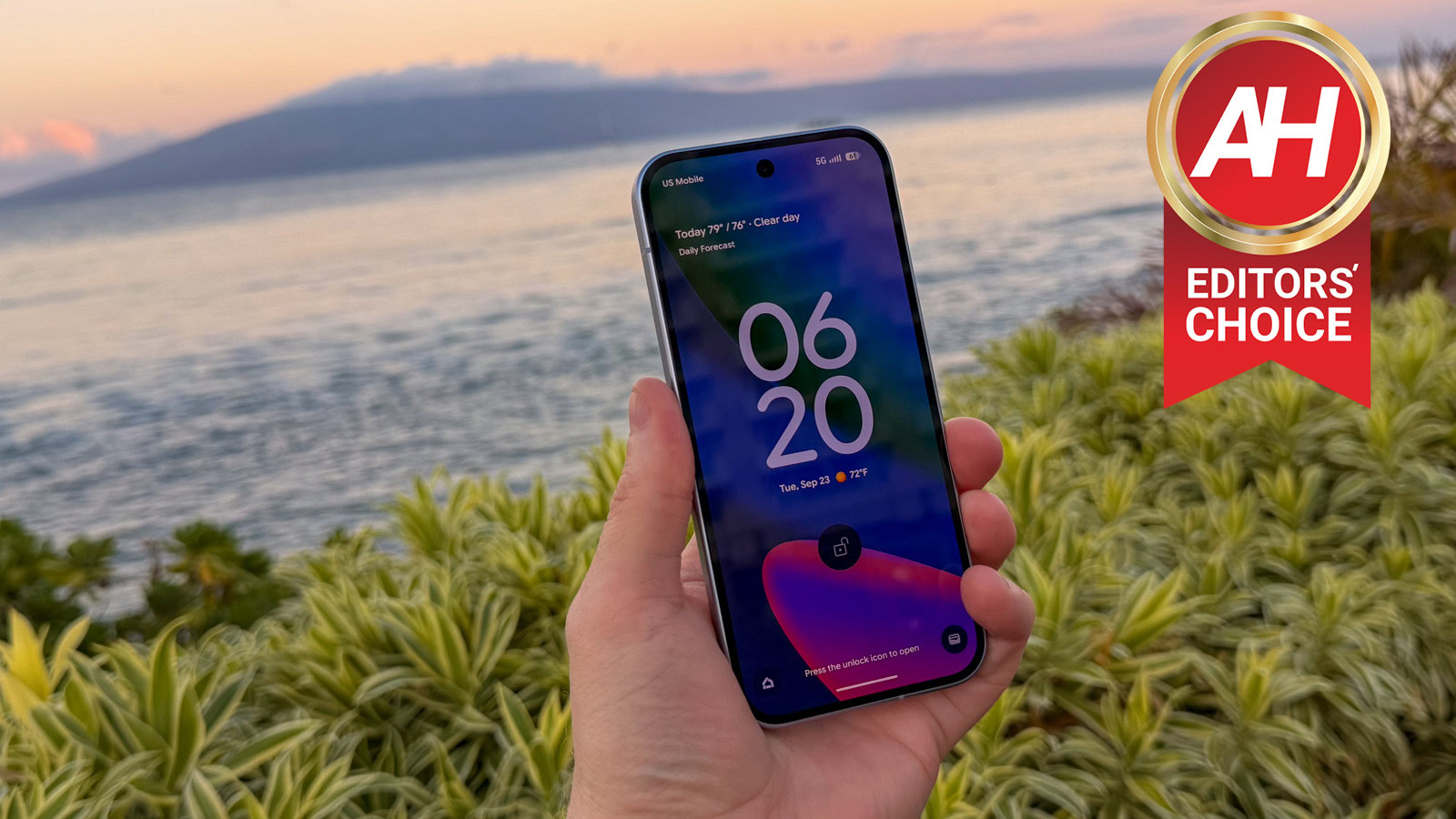
The base model Google Pixel 10 actually got quite a few upgrades this year, perhaps more than the pro models did. In fact, every single camera sensor changed on the back of the Pixel 10, with the addition of the new 5x telephoto for the base model. But does that make the Pixel 10 a good phone to pick up this year? It did not go up in price, so it is still priced at $799, which is the exact same price as the iPhone 17 which has double the storage now.
Let’s find out if you should buy the Pixel 10 or maybe go after one of the Pro models instead, in our full Google Pixel 10 review.
Google Pixel 10 Specs
Google Pixel 10 Specs
Display 6.3″ FHD+ 120Hz LTPO Processor Tensor G5 RAM 12GB Storage 128GB, 256GB Battery 4,970mAh Cameras 48MP primary, 10.8MP 5x telephoto, 13MP ultrawide Colors Indigo, Frost, Lemongrass, Obsidian
Google Pixel 10 Review: Design and build quality
Google did a pretty big redesign on the Pixel last year for Pixel 9, so it’s not a big surprise that they stuck with this design for another year. Though many are upset that it looks “the same” as the Pixel 9, which doesn’t mean a damn thing. Google did make a few changes to make the Pixel 10 a bit better. It’s not a bit more curved, making it feel better in the hand, and it also is a tad thicker and heavier.
Part of the reason for it being a bit thicker is the larger battery. Google has included a 4,970mAh capacity battery here, that is just 30mAh smaller than the Galaxy S25 Ultra which is almost twice the price. It did not add a vapor chamber unfortunately, that is being saved for the “Pro” models. Which we’ll talk more about in the benchmarks section.
The other big change this year for the Pixel 10 is the camera bar. It’s about the same size as last year, but the glass over the camera is longer this year, since it does have three cameras back there. On the Pixel 10, there was only an ultrawide and a primary camera, while Google added a 5x telephoto this year. Which does make it harder to identify with the Pixel 10 Pro and Pro XL models.
It still has the matte aluminum rails and the glossy glass backside. That’s likely not an issue for most people, as you’re going to put a case on the device, but for those that want to go caseless you’ll want to get a lighter color so that fingerprints aren’t as visible. Of course, my favorite is the Indigo color, but Google provided us with the Frost color instead.
Unfortunately, if you did not like the design of the Pixel 9, you’re not going to like the Pixel 10 (or the Pixel 11 or 12, as Google has confirmed that this design is sticking around for at least 2 more generations). It’s actually one of my favorite designs, especially the camera bump since it does not rock on a table like some of the other devices on the market – particularly looking at you Samsung.
Google Pixel 10 Review: Display
Google hasn’t overhauled the Pixel 10’s display, but it has made one upgrade you’ll actually notice: brightness. Peak brightness now reaches up to 3,000 nits, with high brightness mode hitting 2,000 nits. You won’t see those exact figures outside of lab testing, but the effect is clear — even in direct, midday sun, the Pixel 10 stays easy to read. Just as importantly, it holds that brightness longer without dimming as aggressively as some rivals, which makes it a reliable outdoor performer.
Otherwise, the formula remains familiar: a sharp and colorful OLED with deep blacks and strong contrast that makes movies, games, and even simple scrolling feel immersive. It’s protected by Corning’s Gorilla Glass Victus 2, offering an extra layer of reassurance against scratches and drops.
Color is where Google keeps its identity. Instead of cranking saturation like Samsung or leaning overly cool like some iPhones, the Pixel 10 delivers a more natural and balanced look. It’s not flat — colors still pop — but it avoids the eye-strain of oversaturation.
The result is a display that doesn’t try to rewrite the playbook but instead nails the fundamentals. The Pixel 10 might not have the LTPO tech of the Pro models, but it still delivers a bright, accurate, and reliable screen that shines where it matters most.
Google Pixel 10 Review: Performance
Heading into Pixel season, all eyes were on the new Tensor G5. For the first time, Google ditched Samsung’s foundry and tapped TSMC’s N3E process to build its custom chip. That immediately sparked hopes of a massive performance leap — maybe even Snapdragon 8 Elite–level horsepower. But that was never really Google’s goal. Instead, the focus has always been on consistency, efficiency, and enabling Pixel-exclusive features. This year, that includes a custom-built ISP designed specifically to push the Pixel camera further — something we’ll dig into more later in this review.
In day-to-day use, the Tensor G5 performs exactly as I expected: smooth, stable, and refreshingly cool. It doesn’t overheat, it doesn’t bog down, and within a couple of days I honestly stopped thinking about what chip was inside. That’s a win in my book.
This also reinforces why benchmarks just don’t tell the whole story. On paper, the Pixel 10 Pro isn’t a gaming powerhouse, and if you’re looking for maxed-out FPS in every title, you’ll be happier with a dedicated gaming phone. But in reality, it handles demanding games like Genshin Impact just fine. It’s not mind-blowing, but it’s more than enough for the vast majority of people.
Benchmarks
Now, let’s talk about that elephant in the room, benchmarks. We weren’t expecting the Tensor G5 to hit any new records, but it is a nice upgrade over the Tensor G4 in the Pixel 9 series.
Starting off with Geekbench 6. It’s worth noting that this test was done on pre-release software, and the GPU is apparently massively underclocked, which resulted in a much lower score than it should have. We will be testing it again after the phone is released to the public, and hopefully it is fixed then. But as of now, here’s how the Pixel 10 Pro stacks up to the Pixel 9 Pro, Galaxy S25 Ultra and the OPPO Find X8 Pro.
The reason for these devices in our comparison is that the Pixel 9 shows the year-over-year difference from Tensor G4 to Tensor G5. And the Galaxy S25 Ultra and OPPO Find X8 Pro run on the other flagship chips for 2025, the Snapdragon 8 Elite and Dimensity 9400.
Now, Google does not say how much better the Tensor G5 is versus the Tensor G4, other than to say it is faster. But we can see that the lack of a vapor chamber is really making a difference here. As the single-core score is actually lower than the Pixel 9, and multi-core is just barely higher. Of course, the GPU score is incredibly low, which is something we’ve seen on all three Pixel 10 devices we’ve reviewed so far.
Next up is AnTuTu. WIth AnTuTu this test tests every aspect of the device. From the storage, to RAM, to CPU speed and everything in between. So here’s how it stacks up.
Unsurprisingly, the AnTuTu score is higher than on the Tensor G4, but still far behind the Snapdragon 8 Elite and Find X8 Pro.
The final benchmark we run is a video export test. What we do with this test is we load up the same 60-second video into Capcut and export it at 4K60, timing how long the export takes. It is generally fairly quick, but here’s how all four devices stacked up.
So it’s a pretty good increase from last year’s Tensor G4, but again, it’s still behind the other flagship chips, which is what we expected. And this just goes to show that benchmark scores really aren’t the end-all, be-all.
Thermals
Now let’s talk about Thermals. For thermal testing, we have four different tests. First, we run the 3D Mark Wildlife Extreme Stress Test. This is designed to push the device to its absolute limits and it will get about the hottest it ever will. This really shows how far companies will let devices go before throttling them.
As we can see here, the Pixel 10 does stay a bit cooler, which is good to see, but still nothing like what the Galaxy S25 Ultra is able to accomplish. Most devices we test hit around 109 to 111° in this test. So Google is right where it should be.
Next up is playing Genshin Impact for an hour at max graphics and max brightness level. Genshin Impact is a pretty intense game and is known for really pushing devices to their limit.
Similar results here as with the 3D Mark Wildlife Extreme Stress Test, which is not a surprise at all.
Finally, video recording. We test out recording 4K60 video for 10 minutes while taking the temperature at 5-minutes and again at 10-minutes. There’s usually a smaller difference here versus the other tests that we do.
What these tests show us is that the thermals on the Google Pixel 10 are pretty decent, even without the vapor chamber that the pro models have. Of course, having a vapor chamber would really make a big difference here, but the Tensor G5 does a pretty good job of staying cool as well.
Google Pixel 10 Review: Battery life and Charging
Coming into the Pixel 10 review, I was a bit interested to see how battery life would differ compared to the Pixel 10 Pro since it has a larger battery but it does not have the vapor chamber of the larger models. For most part, battery life was pretty similar. I was able to get through a full day and then some. Of course, this did lead to the Pixel 10 being a bit warmer than other devices, since it does not have that vapor chamber to help keep it cool throughout day-to-day usage.
On the charging front, it does still cap out at around 30W which is unfortunate, but since it does last throughout the day, it’s not really an issue for my usage. I’ll just plug it in and let it charge overnight.
Benchmarks
When it comes to battery life and charging, we do have benchmarks for these as well. For battery life, we charge the phone to 100%, and let it stay plugged in for another hour to ensure that is actually at 100%. Because some phones show 100%, but don’t flip over to “Fully Charged” for another half hour – OnePlus is a big culprit of that. Then we set the brightness to about 200 nits, which is very bright, but not max brightness, since not every phone has the same max brightness level. Then we pulled up a YouTube video and played it nonstop until the battery dropped to 1%.
For the Pixel 10, it had a time of 22 hours and 40 minutes. That is pretty similar to the Pixel 9’s runtime in this same test from last year. But I will say, we have noticed that this does show that the Pixel 10 isn’t as optimized for video playback as we’d like to see.
For the charging test, we then plug the phone into a charger that can max out the charging speed, and time how long it takes to go from 1% up to 100%. For the Google Pixel 10, that was about one hour and 36 minutes. A tiny bit shorter than the Pixel 9 was, though it did have a smaller battery.
Google Pixel 10 Review: Software
The Pixel 10 ships with Android 16 QPR1 right out of the box, giving buyers the very latest software from day one. That’s a welcome improvement over last year, when the Pixel 9 launched on Android 14 and had to wait for Android 15. As always, Google is promising seven years of OS and security updates, meaning this phone will stay current and secure well into the 2030s.
Android 16 introduces Material 3 Expressive, Google’s bold new design language. It leans into more dynamic colors, playful shapes, and a refreshed UI that makes the Pixel stand apart from other Android phones. Not everyone will love the shift, but after some time with it, the design feels modern and distinctly “Pixel.”
Where the Pixel 10 shines is in new AI-powered features enabled by the Tensor G5. The most notable is Magic Cue, a contextual assistant that works inside apps like Messages and Phone. It can suggest sharing a restaurant address when friends text about dinner, or automatically surface your flight details during a call with your airline. It’s not perfect yet — sometimes it takes a moment to catch up or misses the context — but it shows promise and will get smarter as it learns your usage.
Another standout is Live Translation for phone calls. With this feature, you can speak in your own language and have it translated in real time for the person on the other end — and only one side of the conversation needs a Pixel 10. It’s not flawless, but it’s an impressive tool for international travel or business. Google says this won’t come to older Pixels because it depends heavily on Tensor G5’s upgraded on-device AI.
Google has also added a new Daily Hub, which lives inside the Discover feed. It brings together snippets from your calendar, weather, Gemini suggestions, YouTube recommendations, and more. Right now, it feels a bit experimental rather than essential, but like many Google features, it could evolve into something far more useful over time.
Overall, the Pixel 10 delivers the smooth, polished software experience we’ve come to expect from Google hardware, with the bonus of new AI tricks. Some features like Magic Cue and Daily Hub still feel like early days, but with quarterly feature drops on the roadmap, they’re likely to improve quickly.
Google Pixel 10 Review: Camera
This year, Google actually changed up every single rear camera on the Pixel 10. It added a 10.8-megapixel 5x telephoto lens, which is the same camera from the Pixel 9 Pro Fold and Pixel 10 Pro Fold, and honestly, it’s not great. But when you look at phones in this price range that actually have a telephoto camera, it’s not too shabby actually.
It also has a 48-megapixel primary sensor and a 13-megapixel ultrawide sensor. Both of these sensors are smaller than the Pixel 9 cameras, which is an interesting move. But keep in mind that Google’s computational photography does work better on these smaller sensors. And we’ve seen that here during our review period of the Pixel 10 camera.
While working on this review of the Pixel 10, I was in Maui for Qualcomm’s Snapdragon Summit, so there’s some pretty interesting camera samples here, including some great night shots, stunning shots of the pacific ocean and much more. Below, I’ve included a number of camera shots from the Pixel 10, all unedited (other than potentially resized so this page doesn’t take ages to load). So you can judge for yourself.
Should you buy the Google Pixel 10?
Now, the big question of whether you should buy the Pixel 10 or not? If I wrote this review before the iPhone 17 launched, I’d say yes, definitely buy it. But now that Apple has drastically upgraded the iPhone 17, and made it a better value than the Pixel 10, it’s hard to say. Of course, if you’re not interested in an iPhone or switching to iPhone, then the Pixel 10 is still a great option. But the iPhone 17 does offer double the storage for the same price.
You should buy the Google Pixel 10 if:
You don’t need the “Pro” experience.
You want a smaller phone, at a smaller price.
You should not buy the Google Pixel 10 if:



